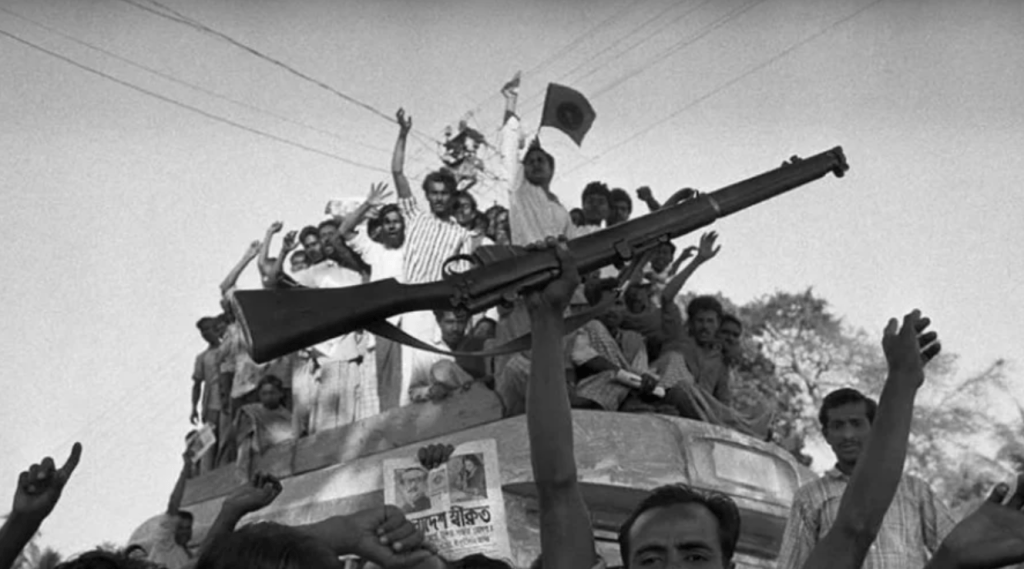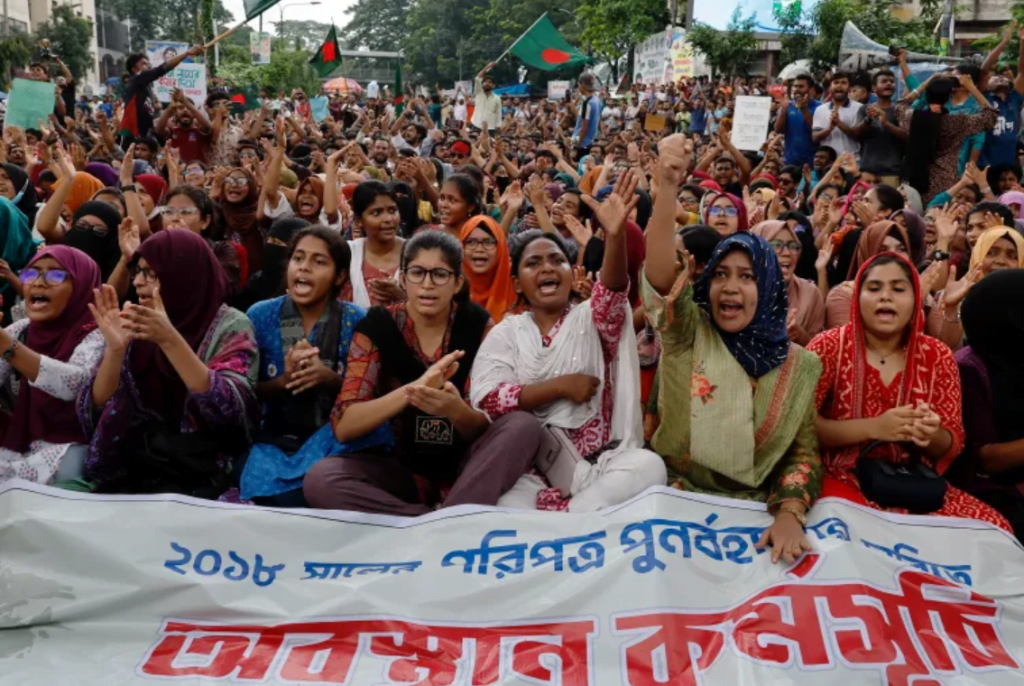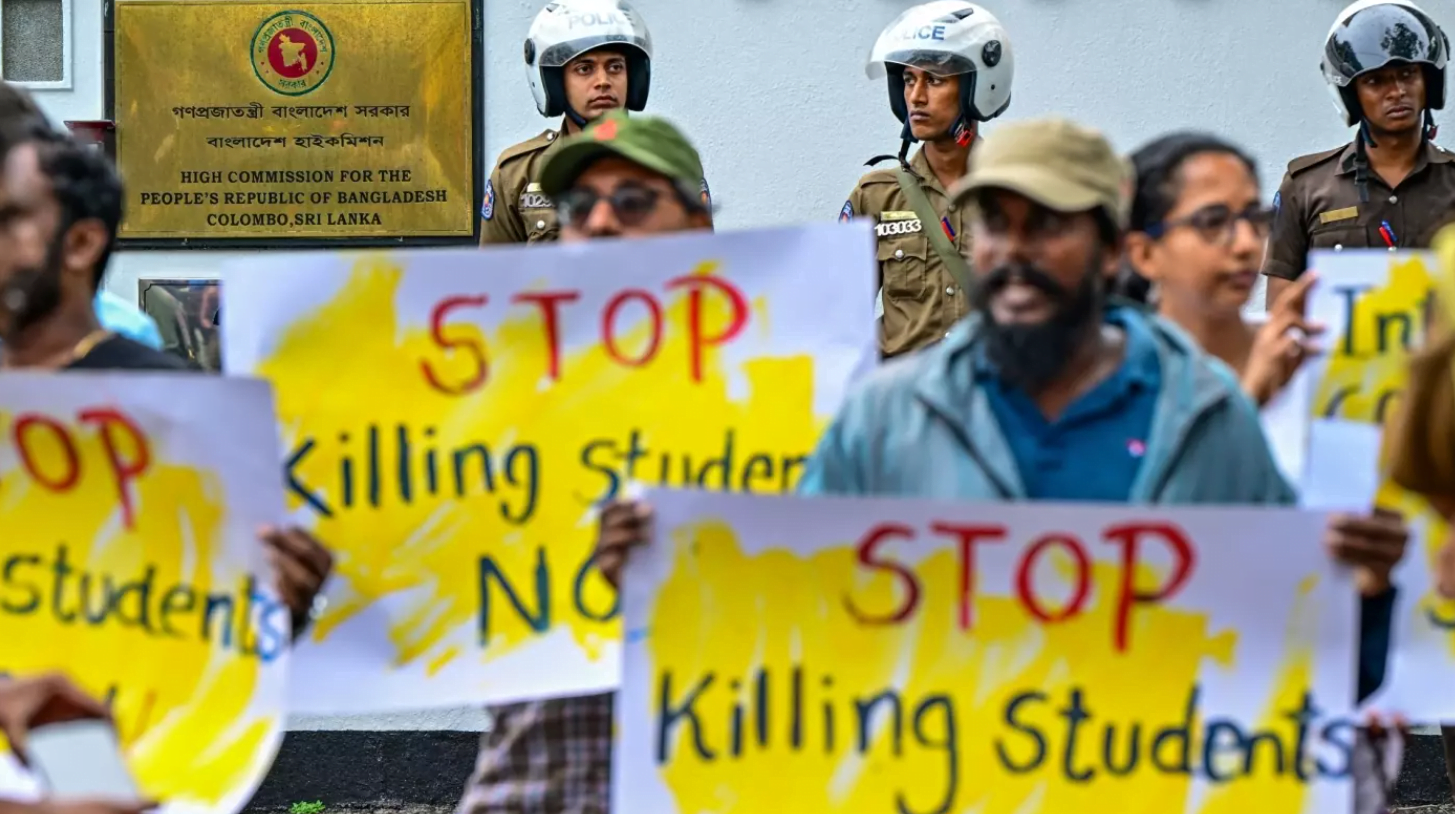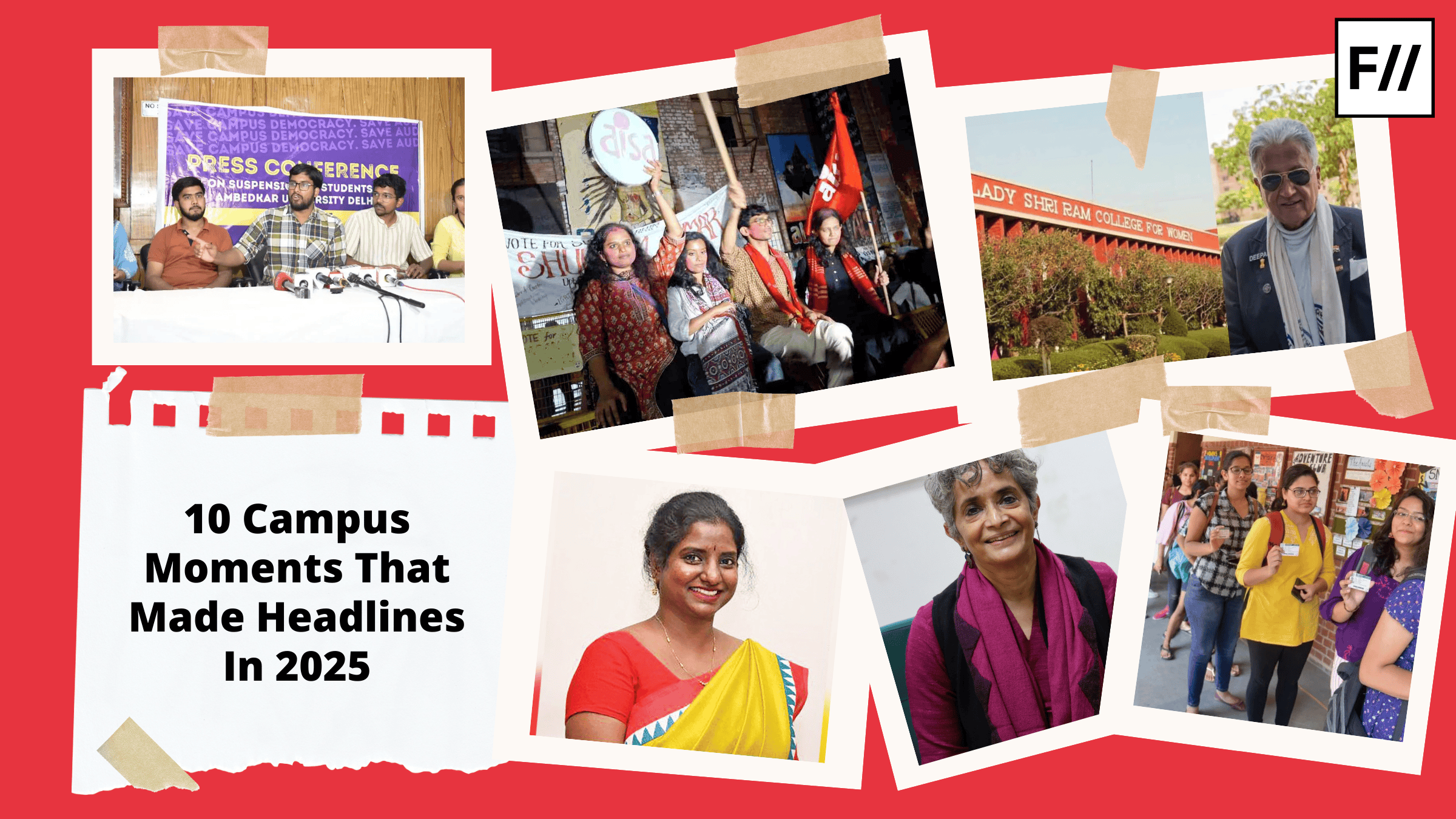The news came on 23rd July that the Bangladesh government, Sheikh Hasina’s cabinet, has formally accepted the Supreme Court’s verdict; two days after the court had scaled back the quota system. At least 180 have been killed, more than 2,500 arrested, state-wide curfews and internet blackout – what caused one of the most lethal political clashes in the recent history of Bangladesh?
Posters asking Hasina to step down have been flooding social media along with violent images of clashes over the past week. In a deadly clash, student protesters locked horns with police and the ruling party’s student faction – as the opposition added fuel to the fire. The general public tried to file the good and bad side of this protest while grasping at random straws from the country’s popular rhetorics. One must revisit Bangladesh’s history to make sense of the spark that caused the bushfire.
The historical context
The Bangladesh Liberation War was waged in 1971, emancipating the country from Pakistan. The eight long months, leaving millions dead, birthed an exhausted but defiant country. Bangladesh’s contemporary socio-political fabric is wrought in the language and emotions of that war. While there were the freedom fighters or Muktijoddhas (war heroes), there were also the pro-Pakistan radical religious militia – the most infamous being the Razakars. The Bangladesh genocide was committed by the Pakistani army and its pro-militia groups.

After independence, the Razakars were dissolved and the Jamaat-e-Islami was banned. Soon after, the members either fled to Pakistan or “disappeared” at the behest of Mukti Bahini (the guerilla front of the freedom fighters). The country has remained reverent and retentive of the freedom movement and its heroes.
After independence, the most prominent leader of the freedom movement, Bangabandhu Sheikh Mujibur Rahman, formed the first government of Bangladesh. He established a quota for the Bangladesh Civil Service (BCS) wherein the government reserved 30 per cent of seats for the veterans of the Bangladesh Liberation War, 10 per cent for women victimised in the war and 40 per cent for people from underrepresented districts. Only 20 per cent of the seats were given up for merit-based recruitment. It was an important move to ensure the sacrifices made for the country’s freedom were rewarded and that the guerilla factions of the independence movement were brought back into the ambit of civil society.
In 1975 the Awami League was overthrown after Sheikh Mujibr Rehman was assassinated. By 1976 the reservation for underrepresented districts had decreased to 20 per cent, increasing the tally for merit-based recruitment to 40 per cent. Further reforms increased the latter to 45 per cent by 1985. 26 years after independence the freedom fighter recruitment naturally decreased but instead of changing the reserved seat percentage, the policy was extended to the children of the Muktijoddhas in 1997, during Sheikh Hasina’s first term.
By 2008 trouble was stirring as two retired civil servants, one of whom was a freedom fighter himself, called for reforms in the faulty quota system. Two years later, under the re-elected Awami League government, the 30 per cent quota for the war heroes and their children was further extended to the grandchildren, and an additional 1 per cent was reserved for persons with disabilities. The tally for merit-based recruitment stood at 44 per cent.
Quota reform movement – 2018 and 2024
Civil society began its movement for quota reform in 2018 after a writ petition, challenging the legality of the quota system, was rejected. The protest, like most major movements in Bangladesh was led by students – beginning in Shahbagh and Dhaka University. Amidst myriad related demands, the protesters sought a reduction of the overall reservation from 56 per cent to 10 per cent. Peaceful gatherings, rallies and blockades were met with violence from the student wing of the Awami League – Bangladesh Chhatra League (or BSL) along with students from allied organisations like Muktijoddha Santan Command. Wielding hammers, machetes and sticks the political goons of BSL made headlines for attacking, injuring and even maiming students while the police watched. The five-month-long protest ended with Hasina’s government issuing a circular, dismissing the quota system.

All should have been well, but trouble began when the High Court reinstated the 30 per cent quota based on a suit filed by the “children of nationally recognised freedom fighters” – summarily striking down the 2018 circular. It would be important to remember that the circular was issued in 2018, right before the general elections, while the scrapping of the same took place in 2024, right after Sheikh Hasina won a controversial election and her fourth consecutive term.
The 2024 protest began in multiple universities in Dhaka immediately after the court’s verdict. Due to Eid and the summer holidays, there was a brief hiatus in the movement after which it regained momentum. As the protest spread across universities, on 10th July the Appellate Division stated that the quotas shall remain cancelled till the Supreme Court heard the case in four weeks – 7th August. The move hoped to douse the fire, building across the country, but the protesters refused to return to their classes and wanted a final verdict.
Unfortunately, the Bangladesh crisis had deeper roots than the public sector job reservation. Authoritarian policies, post-covid market stagnation, widening economic gap and growing pressure from neighbouring countries have caused widespread public disaffection, significantly destabilising the government’s legitimacy and hold on the State.
The protest, which turned into a battlefield
The movement quickly snowballed, questioning the Awami League’s corruption, as the party members stood to benefit from the 30 per cent reservation. It naturally questioned the government’s authority and efficiency. The Bangladesh Chhatra League was back on the field, and this time with a more active police force. Unlike the 2018 movement, this protest garnered support from Awami’s major opposition, the Bangladesh National Party (BNP).
The authoritarian trends of the subcontinent show similar patterns – obliterate the opposition to maintain an image of democracy, no matter how illiberal.
The 2024 election was boycotted by BNP, alleging Hasina’s government conducted a rigged and unfair election, as some of the leading faces of the party were arrested in the last few years. The authoritarian trends of the subcontinent show similar patterns – obliterate the opposition to maintain an image of democracy, no matter how illiberal. At such a condition it was natural for BNP to try and make the most of a populist movement like quota reform. But the cost was a peaceful student protest turning into a lethal battlefield. Political warheads clashed for their motives and agenda, undermining the cause and rhetoric of civil disobedience.

BNP’s conflicted association with the Jamaat-e-Islam and its history of a volatile ideology makes the narrative even more murky. Awami League led the independence movement while the Jamaat-e-Islam has a notorious history of religious fanaticism and war crimes during the liberation war. The moment their names were attached to the movement it gave Awami the moral right to defend itself.
Sheikh Hasina made matters ten-fold worse on 14th July when she called the protesters the dreaded curse – Razakars, traitors of the land. The Awami government has been known to leverage political and emotional capital using the rhetoric of the Razakars, including the public executions held in her previous term. Protests turned on their heads as hallways and streets rang with student slogans screaming, “Tui ke? Ami ke? Razakar, razakar! Ke boleche, ke boleche, sairachar- sairachar.” (Who are you? Who am I? Razakar, Razakar! Who says that, who says that, dictator, dictator) The violence grew at an unexpected speed, leaving dozens dead overnight. Social media chopped up that slogan to divide the mass opinion, aggravating the polarised online narrative.
Tear gas and rubber bullets by the police, hammers and machetes by the student associations – the protest violence swung off the handle. Unprecedented images surfaced online – helicopters firing on the ground, students being shot point blank, buildings on fire and more. Medical reports indicated the use of fire ammunition instead of rubber bullets. Protests reached beyond borders as the diaspora mounted protests and asked for Hasina to step down. This is a huge blow to the freshly elected government which has maintained a facade of stability, using an iron grip.
Democracy stands on popular mandate and the discontent and disaffection smites the legitimacy of the current cabinet. BSL’s legacy of hooliganism and violence was upheld through their demonstration of force in this protest. It is surprising to dive into the student wing’s history, not to mention the 1999 anti-rape movement horror. One wonders why a democratic and independent country would need a militia to tackle student protests and keep universities in check.
Having said that it is important to take note of the attacks by anti-quota student activists. They have injured Chhatra League students and destroyed public properties, including setting buildings on fire. The saddest damage has been the series of collateral deaths of citizens. A 6-year-old succumbed to her injuries after being shot by a stray bullet when she was on her home terrace with her parents. Social media spun narratives of violence in dedicated silos, coloured to serve audiences their preferred versions of skewed perspectives and half-truths. Emotions rose at a feverish pace. The government levied curfews, shoot-on-sight orders and internet blackouts to combat the situation – which at best can bottle the seething anger of the civil society.
The authoritarian legacy and the threat of economic crisis in Bangladesh
By 1972 Sheikh Mujibur Rahman’s democratic ideals took a southward turn in the face of left-wing insurgency. To tackle the Marxist Gonobahini, Mujibur established a paramilitary force – Jatiya Rakkha Bahini, that wreaked havoc with impunity. They were blamed for delivering extrajudicial killings, death squads, rape and other human rights violations – all with legal protection.
Right before the coup d’etat and horrific assassination of Mujibur and most of his family, the prime minister had changed the constitution, declared himself president and begun a one-party system in Bangladesh through the Bangladesh Krishak Sramik Awami League (BAKSAL). This history casts its shadow upon Hasina’s increasingly authoritarian rule – from branding the opposition party as a “terrorist” organisation to intolerance towards dissent. She has been lauded for opening doors to Rohingyas from Myanmar, handling the pressure from China and India while maintaining good relationships with both, and keeping tight surveillance on religious extremist groups – including surviving a coup d’etat attempt in 2011. She is a shrewd strategist and diplomat but her intolerant authority needs democratic editing.
The economic crisis is escalating as more than two-thirds of Bangladesh’s 170 million population is of working age, threatened by inflation, unemployment, financial insecurity, malnutrition and hunger. The mythical highway of development is a rhetoric Indians are familiar with. The big infrastructure projects are touted as the litmus test of this development, dismissing any report or data. While indeed such projects are totems of corruption and inefficiency.
India is a happy partner in weaving this propaganda as NTPC leads the controversial Rampal Power Plant, positioned to destroy the natural ecosystem of an already vulnerable Sunderban. Not only that, the economic boom that Hasina gets praise for is carried by the female workforce at the sweatshops of the garment industry – who enjoy little to nothing of this grand escalation.
The Supreme Court, seeing the urgency of the situation, met on the 21st of July to hear the case. It disqualified the lower court’s verdict as illegal. It confirmed that the quotas shall be dissolved – opening up 93 per cent of seats to merit-based recruitment and reserving 7 per cent to all other categories, including children of war veterans. The government clampdown on the protestors and the heavy-handed use of force has aggravated the general public anxiety. As the disturbing quiet descends on the news portals and the streets of Bangladesh – student protestors and citizens await the next move of a vindictive government.
The students’ demand for an apology has not been meted by Sheikh Hasina yet, and cannot be expected given the current image of her government. After the 2018 protests, there were long-drawn effects in arrests and violence. The student protesters continue to press the issue of releasing the arrested demonstrators and action against authorities involved in the violence. India’s allegiance with Hasina will only mean continued silence on Bangladesh’s “internal matters.”
A crucial political chess piece in the battle between India and China (and Pakistan), Bangladesh looks at an insecure future. One can hope that sense shall prevail over authority and that the state is given the time it needs to heal from the wounds of this protest and its aftermath.
About the author(s)
She/they is an editor and illustrator from the suburbs of Bengal. A student of literature and cinema, Sohini primarily looks at the world through the political lens of gender. They uprooted herself from their hometown to work for a livelihood, but has always returned to her roots for their most honest and intimate expressions. She finds it difficult to locate themself in the heteronormative matrix and self-admittedly continues to hang in limbo




